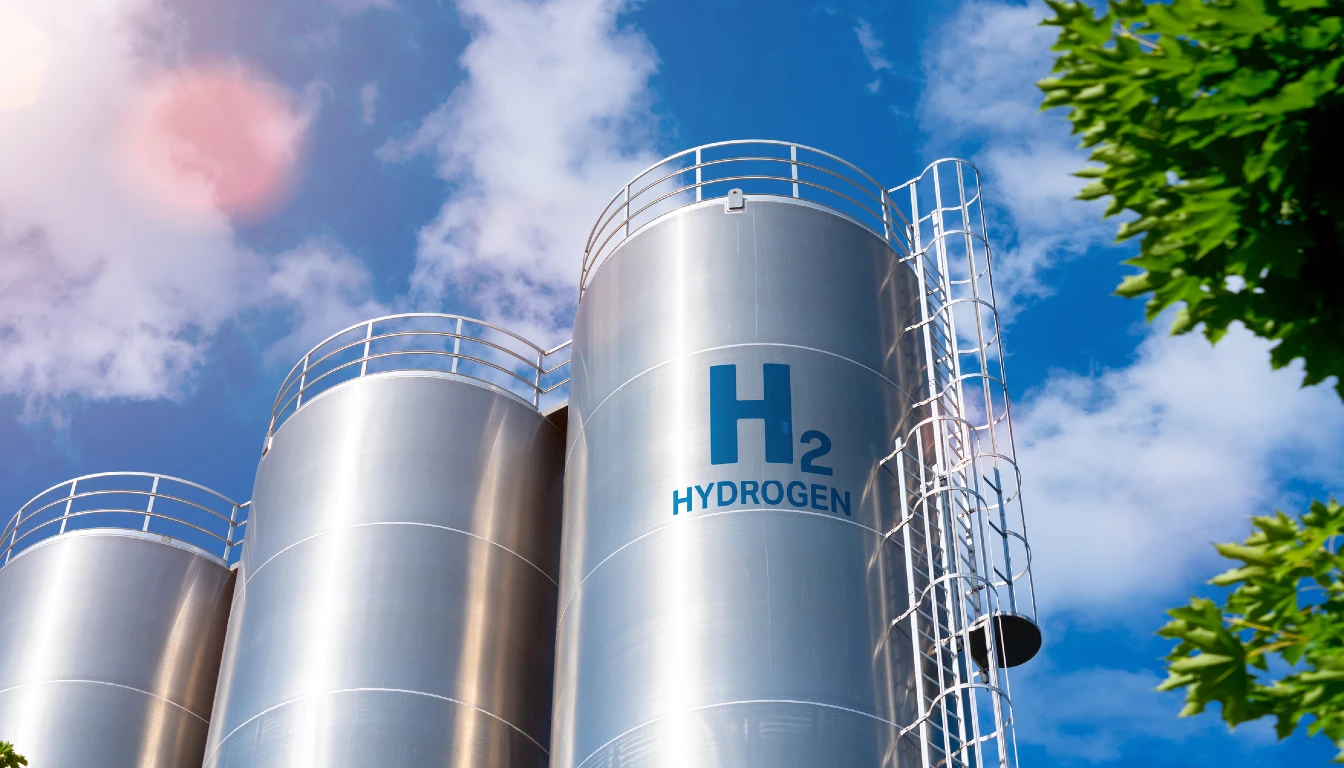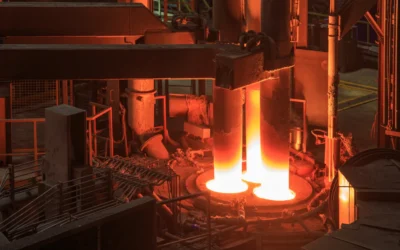As the world looks for sustainable energy alternatives, hydrogen has emerged as a promising candidate to replace fossil fuels in some industries and for some purposes. This versatile element can power everything from vehicles to industrial processes, offering a cleaner, more efficient energy solution in its use.
But it also has drawbacks – production isn’t simple, transportation can be difficult and inefficient and because of this, the actual sustainability benefits are not always clear-cut.
Here, we look at some of the most promising hydrogen technologies, early adopters, growing applications, transportation and storage methods, and the regulatory landscape, alongside government investments in hydrogen.
Hydrogen Production Technologies
Hydrogen is one of the most plentiful elements on earth. But it’s often embedded in compounds – like water – requiring processes to access it. Some of the key processes are:
Electrolysis
Electrolysis is the process of splitting water into hydrogen and oxygen using electricity. This method, particularly when powered by renewable energy sources like wind or solar, produces what is known as green hydrogen. Companies like Siemens and ITM Power are advancing electrolysis technology, improving efficiency and reducing costs.
Sounds good on the face of it, but there are substantial issues in doing this at scale.
Key issues with green hydrogen production include:
- Energy Efficiency: Current electrolysers have 60-70% efficiency, with significant energy loss. Improving catalyst and membrane technology is crucial. Reliance on renewable energy, which is intermittent, also poses challenges.
- Cost: High initial capital costs and ongoing operational costs hinder widespread adoption. Advances in technology and economies of scale are needed to reduce these costs.
- Materials and Resources: Electrolysers use scarce materials like platinum and iridium. Research into alternative catalysts is ongoing. Additionally, water demand, though modest, requires sustainable management.
- Infrastructure: Integrating electrolysers with the electrical grid and developing distribution and storage infrastructure are significant hurdles. Hydrogen’s transport and storage require substantial investments in pipelines, tanks, and other technologies.
- Environmental Concerns: The entire lifecycle of hydrogen production must be environmentally sustainable. Increased renewable energy demand for hydrogen production should not lead to fossil fuel resurgence.
- Technological Advancements: Alkaline, PEM, and SOEC electrolysers each have unique challenges. Improving efficiency, cost, and durability is essential. Integrating electrolysers with variable renewable energy sources requires hybrid systems and advanced technologies.
- Economic and Policy Framework: Developing a stable hydrogen market and supportive government policies is vital. Subsidies, tax credits, and international cooperation can drive research, development, and deployment.
Addressing these challenges is critical for hydrogen electrolysis to become a viable, large-scale green hydrogen solution, supporting the transition to a low-carbon energy future.
Steam Methane Reforming (SMR) with Carbon Capture and Storage (CCS)
Steam Methane Reforming involves a reaction between methane (CH₄) and steam (H₂O) at high temperatures to produce hydrogen (H₂), carbon monoxide (CO), and a some carbon dioxide (CO₂).
SMR is highly efficient, with overall efficiencies typically ranging from 65% to 75%. It’s also a mature and well-understood technology, making it the most common method for industrial hydrogen production. The infrastructure and expertise for SMR are widely available. Compared to other hydrogen production methods, SMR is also relatively cost-effective, especially where natural gas is abundant and cheap.
So while SMR has definite positives, the associated carbon dioxide emissions and dependence on fossil fuels present significant challenges.
The integration of CCS could help reduce the environmental impact, making SMR a viable transitional solution as the world moves towards more sustainable hydrogen production methods.
But this production method is only ever destined to serve as a transitional technology, leveraging existing natural gas infrastructure.
Solid Oxide Fuel Cells (SOFCs)
Solid Oxide Fuel Cells (SOFCs) convert hydrogen into electricity through an electrochemical process, suitable for stationary power generation.
SOFCs are high-efficiency devices that generate electricity by reacting hydrogen or hydrocarbons with oxygen at high temperatures (600°C to 1,000°C) using a solid ceramic electrolyte. They offer advantages like high electrical efficiencies (50-60%), fuel flexibility (hydrogen, natural gas, biogas), and long-term stability. However, they face challenges such as material degradation, long start-up times, thermal management issues, and high costs due to expensive materials and manufacturing processes.
SOFCs are suitable for stationary power generation, industrial applications, and remote or marine power, leveraging their high efficiency and ability to utilize waste heat. Overcoming the technical and economic barriers through advances in materials and manufacturing techniques is essential for wider adoption. Despite current challenges, SOFCs hold significant promise for contributing to a sustainable energy future with reduced greenhouse gas emissions.
Companies like Bloom Energy are leading in SOFC development, offering efficient, scalable power solutions for industrial and commercial use.
Early Adopters and Growing Applications
Transport
Passenger Cars / Hydrogen Fuel Cell Vehicles (FCVs)
Hydrogen FCVs are at the forefront of early adoption, with companies like Toyota (Mirai) and Hyundai (Nexo) producing commercially available passenger car models powered by hydrogen. These vehicles offer longer ranges and faster refueling compared to battery electric vehicles (BEVs). But while the number of refueling stations is growing, slowly, they are not yet widespread.
Toyota in particular has stuck by its vision of widespread hydrogen car use: this partly explains why they have trailed in the development of an EV portfolio.
Heavy-Duty Transport
Hydrogen’s high energy density and quick refueling makes it ideal for heavy-duty applications like trucks, buses, and trains.
Key advancements include Nikola Motors’ hydrogen trucks with ranges up to 500 miles and Hyundai’s XCIENT Fuel Cell trucks in Europe. European cities and China are adopting hydrogen buses, while Alstom’s Coradia iLint hydrogen train operates in Germany. The maritime sector is developing hydrogen-powered ships, like Norled’s ferries in Norway, aiming for zero-emission transport.
The growth of hydrogen fuel stations for trucks is accelerating globally. North America and Europe are expanding their networks, with significant projects from companies like Nikola Motors and government initiatives in cities adopting hydrogen buses, ensuring convenient and widespread refueling infrastructure.
Industrial Applications
Hydrogen could, in theory, be used in many industrial and chemical production processes. The relative difficulty of producing, transporting and storing it, however, means that it often isn’t a practical or cost-effective alternative to traditional fossil fuels like coal.
Steel Production
The steel industry, a significant CO2 emitter, is exploring hydrogen-based reduction processes to produce green steel. Companies like SSAB in Sweden are pioneering this approach, aiming to replace coal with hydrogen.
SSAB, in collaboration with LKAB and Vattenfall, is leading the HYBRIT (Hydrogen Breakthrough Ironmaking Technology) initiative. HYBRIT aims to replace coal in the steel-making process with hydrogen, which produces water instead of CO₂. SSAB’s pilot plant in Luleå, Sweden, has already produced the world’s first hydrogen-reduced sponge iron.
Other companies, largely in Europe, are also experimenting with hydrogen instead of traditional fossil fuels.
Salzgitter AG is developing the SALCOS (Salzgitter Low CO₂ Steelmaking) project to decarbonize steel production. This initiative includes the use of hydrogen for direct reduction of iron ore. Salzgitter has partnered with Sunfire GmbH to use their high-temperature electrolysis technology for green hydrogen production.
ArcelorMittal is exploring several hydrogen-based projects to reduce CO₂ emissions. In Hamburg, Germany, they are testing a direct reduction plant that uses hydrogen to produce direct reduced iron (DRI). This pilot project aims to demonstrate the feasibility of hydrogen as a reducing agent in steel production.
Tata Steel is working on the HIsarna project at its IJmuiden plant, which aims to reduce CO₂ emissions by integrating hydrogen into the steel-making process. The project focuses on converting iron ore to iron using hydrogen instead of carbon-based materials.
Thyssenkrupp is developing its Carbon2Chem project, which includes using hydrogen to produce steel. The project aims to capture and convert steel-making emissions into chemicals, utilizing hydrogen as a key component. Thyssenkrupp is also planning to build a hydrogen-based direct reduction plant in Duisburg.
Chemical Industry
Green hydrogen, produced via electrolysis powered by renewable energy, is transforming the production of ammonia and methanol, crucial chemicals with significant industrial applications.
Traditionally, ammonia is produced through the Haber-Bosch process using hydrogen derived from natural gas, resulting in substantial CO₂ emissions. By using green hydrogen, the process combines this hydrogen with nitrogen from the air to produce ammonia without emitting CO₂. This green ammonia is vital for fertilizers and as a potential carbon-free energy carrier.
Methanol is typically produced from syngas (a mixture of hydrogen, carbon monoxide, and CO₂) derived from natural gas or coal, also emitting significant CO₂. Green hydrogen, combined with captured CO₂, can produce methanol through hydrogenation, yielding methanol and water. Green methanol serves as a chemical feedstock and fuel, with a much lower carbon footprint.
Notably, Yara International and Siemens-CF Industries are advancing green ammonia projects. And Carbon Recycling International (CRI) in Iceland produces renewable methanol using green hydrogen and CO₂.
Other sectors
Beyond steel and chemicals, hydrogen is being explored in various industrial processes to reduce emissions and enhance sustainability:
- Cement Production: Hydrogen can replace coal and natural gas in cement kilns to lower CO₂ emissions.
- Glass Manufacturing: Hydrogen serves as a clean fuel for high-temperature furnaces.
- Refineries: Switching to green hydrogen for hydrocracking and desulfurization can cut emissions.
- Food and Beverage: Hydrogen powers ovens and boilers, reducing fossil fuel use.
- Textiles and Pape*: Hydrogen offers a cleaner alternative for heating and steam generation.
- Mining Operations: Hydrogen fuel cells power heavy machinery, reducing environmental impact.
- Electronics Manufacturing: Green hydrogen is used in semiconductor production.
- Transport and Logistics: Hydrogen fuel cells power trucks, buses, forklifts, and material handling equipment.
These developments showcase hydrogen’s potential to decarbonize various high-emission industries, but it remains a more costly and less practical option than the status quo.
Energy Storage and Power Generation
Grid-Scale Energy Storage
Hydrogen can stabilize the electrical grid by storing excess renewable energy and releasing it during peak demand.
During periods of surplus renewable energy production, electrolysers use this excess electricity to split water into hydrogen and oxygen. The hydrogen is then stored as compressed gas, liquid hydrogen, or in chemical compounds. When demand exceeds supply, the stored hydrogen is converted back into electricity via fuel cells or combustion turbines.
Fuel cells generate electricity by combining hydrogen and oxygen, while combustion turbines burn hydrogen to produce power. This process helps balance supply and demand, provides reliable backup power, and aids frequency regulation.
Hydrogen storage systems are scalable and can store energy for long periods, making them ideal for integrating with renewable energy sources and enhancing grid stability. This approach supports a more reliable and sustainable energy system by ensuring consistent power delivery despite the variability of renewable energy sources.
Projects like the European HyDeploy aim to integrate hydrogen into natural gas networks, leveraging existing infrastructure.
Backup Power Systems
Hydrogen fuel cells offer reliable, clean backup power for critical infrastructure like data centers. They provide continuous power as long as hydrogen is supplied and can quickly start to ensure immediate backup during outages.
Generating electricity through an electrochemical reaction, fuel cells emit only water and heat, making them environmentally friendly and reducing the carbon footprint, especially when using green hydrogen.
Fuel cells are highly efficient, modular, and scalable, allowing them to meet specific power needs while offering low maintenance and quiet operation. On-site hydrogen production and storage enhance energy security, providing grid independence and ensuring a steady fuel supply.
By adopting hydrogen fuel cells, data centers can achieve reliable, uninterrupted power, reduce emissions, and contribute to sustainability goals, making them an attractive alternative to traditional diesel generators.
Companies such as Microsoft are experimenting with hydrogen fuel cells for their data centers.
Storage and Transportation of Hydrogen
Storage
Hydrogen storage is essential for using hydrogen as an energy carrier, especially for renewable energy integration, transportation, and industrial processes. Effective storage solutions need to address energy density, cost, safety, and infrastructure challenges. Some of the main methods of hydrogen storage are:
Compressed Gas Storage
Hydrogen is stored in high-pressure tanks (350 to 700 bar). This mature technology is widely used, particularly in hydrogen fuel cell vehicles (FCVs). While it is relatively straightforward, the energy density is lower compared to other methods, requiring larger storage volumes. High-pressure storage also necessitates strong, durable materials, increasing costs.
Liquid Hydrogen Storage
Hydrogen is cooled to -253°C and stored as a liquid in insulated containers. This method offers higher energy density, making it suitable for space-constrained applications like aerospace. However, maintaining cryogenic temperatures requires significant energy and specialized insulation, increasing complexity and cost. There are also boil-off losses over time.
Chemical Storage
Hydrogen can be stored in chemical compounds such as metal hydrides, ammonia, or liquid organic hydrogen carriers (LOHCs). Metal hydrides provide high volumetric energy density and safety but have slow hydrogen release rates. Ammonia has high energy density and established infrastructure but is toxic and corrosive. LOHCs offer safe handling and use existing infrastructure but require energy-intensive processes to release hydrogen.
Underground Storage
Hydrogen can be stored in underground caverns, salt domes, or depleted natural gas fields. This method is cost-effective for large volumes and suitable for grid-scale storage but requires suitable geological formations and poses risks of leakage and contamination.
Advanced Materials
Research into advanced materials like metal-organic frameworks (MOFs) and carbon-based materials is ongoing. These materials could offer high storage capacities at low pressures and ambient temperatures, but they are still in the research phase, facing challenges in scalability and cost.
Transportation
Pipelines
Hydrogen can be transported through existing natural gas pipelines with modifications or new dedicated hydrogen pipelines. Projects like the European Hydrogen Backbone propose creating a trans-European hydrogen network by 2040.
Tanker Trucks
For shorter distances, hydrogen can be transported in compressed or liquefied form using tanker trucks. This method is currently used for industrial hydrogen supply.
Shipping
Liquid hydrogen shipping is being developed for international transport. Kawasaki Heavy Industries has launched the world’s first liquefied hydrogen carrier, Suiso Frontier, facilitating large-scale hydrogen trade.
Novel methods
Newer transportation options are emerging too, often in tandem with transportation of key materials in industrial processes.
For example hydrogen can be embedded in iron ore for transportation to steel plants. This involves using hydrogen to reduce iron ore into direct reduced iron (DRI), significantly cutting carbon dioxide emissions in steel production. This method replaces carbon with hydrogen in the reduction process, producing water vapor instead of carbon dioxide. The DRI, containing embedded hydrogen, is then transported to steel manufacturing sites for further processing using electric arc furnaces (EAFs), which can be powered by renewable energy. This approach decarbonizes the steel industry, leverages existing logistics for iron ore, and promotes the use of green hydrogen.
Regulatory Issues
Safety Standards
Hydrogen’s flammability requires stringent safety standards for production, storage, and transport. Regulatory bodies like the International Organization for Standardization (ISO) and the U.S. Department of Energy (DOE) are developing safety guidelines to ensure secure handling.
Infrastructure Development
Regulatory frameworks must support infrastructure development, including pipelines, refueling stations, and storage facilities. Policies promoting public-private partnerships and streamlined permitting processes are essential.
Incentives and Subsidies
Governments are implementing incentives like tax credits, grants, and subsidies to promote hydrogen adoption. The European Union’s Green Deal, for example, includes significant funding for hydrogen projects.
Government Investment
Europe
The European Union is a leader in hydrogen investment, with the EU Hydrogen Strategy aiming to install 40 GW of electrolysers by 2030. Countries like Germany, France, and the Netherlands have substantial national hydrogen strategies, investing billions in research, infrastructure, and pilot projects.
Asia
Japan and South Korea are pioneering hydrogen economies. Japan’s Basic Hydrogen Strategy targets a hydrogen-based society, with investments in fuel cell vehicles and hydrogen production. South Korea’s Hydrogen Economy Roadmap aims to deploy 5.26 million hydrogen vehicles by 2040.
North America
The U.S. is ramping up hydrogen investments, with the DOE’s Hydrogen Energy Earthshot initiative targeting $1/kg hydrogen by 2030. California is a front-runner, with extensive hydrogen refueling infrastructure and incentives for hydrogen FCVs. Canada’s Hydrogen Strategy focuses on green hydrogen production and export potential.
Shows potential, room for improvement…
Hydrogen is a versatile and promising alternative to fossil fuels, with applications spanning transportation, industrial processes, and energy storage. Early adopters in the automotive and heavy-duty transport sectors are demonstrating hydrogen’s potential, while industrial applications offer significant decarbonization opportunities. Effective transportation and storage solutions are critical to hydrogen’s success, necessitating advancements in infrastructure and technology.
Regulatory frameworks and government investments are pivotal in driving hydrogen adoption. With robust safety standards, supportive policies, and substantial funding, hydrogen can play a crucial role in achieving global climate goals.
But – and this has been true for a long time – hydrogen has failed to live up to its promise.
As technology advances and economies of scale are realized, hydrogen’s role in the energy transition should continue to expand, offering a more sustainable path forward.




